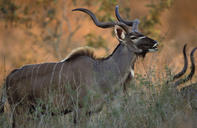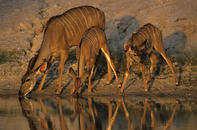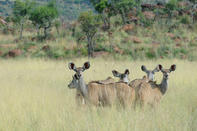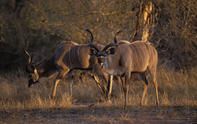Dimorphic
There is a well developed sexual dimorphism in kudu and this has to do with their breeding strategy. Sexual dimorphism means that the male and female look different from one another. The male has the most impressive horns of all the African antelope (record 69.3 inches, ave 47 inches) and is larger than the female.

Male kudu have pale yellowish legs and strong thick necks with a beard of hair. The impressiveness of the male kudu has developed to complement their passive dominance system.
Kudu bulls don’t maintain territories and for most of the time are tolerant of one another. But when it comes time to breed, bulls will weigh up their opponents by a show of their good looks.
Like two boxers in a ring, opposing kudu will engage in lateral presentation, sizing each other up while marching in a circle head to flank with one another. Swollen necks, raised manes and a stiff-legged gait all serve to make the individual appear more impressive.
The inferior contender gives way passively to the more superior. Only if the two animals are equally matched will they engage in horn-clashing combat.
Group Harmony

Kudu are gregarious meaning they prefer to live together in groups. The females live in small groups of about half a dozen individuals made up of one or two cows and their offspring. Cows tend to have lasting associations with one another.
Bulls associate in transitional bachelor groups where they can enjoy safety in numbers while not breeding.
Sometimes they will be solitary or accompany a herd if in attendance of a cow in oestrus (even out of the breeding season). Herds of kudu may combine to create aggregations of 20 or so individuals in areas of good feeding.
Winter Breeding

Kudu breed in the winter time. The reason for this is so that the calves arrive during the rainy season when there is plentiful browse for the lactating cows.
Most calves arrive in February, which is when the grass is longest too. This is vital because kudu calves have a lying up period where the young will hide in the long grass while they grow and gain enough strength to keep up with the herds.
This may take between one and three months. The cows will visit the calves to feed them and keep an eye out for danger. The calves have no scent during this time and so long as they stay still and hidden, they are hard to detect by predators.
The kudu cow will remove all traces of the afterbirth by eating them so as not to attract predators into the area where she has given birth.
Winter Woes

Winter time is a stressful time of year for browsers to breed as food reserves are low. To compound the stress for rutting kudu bulls, they only have a short and competitive window of opportunity to breed. Kudu bulls mature relatively late in life at about 5 years old, compared to 2 years maturity in females.
Understandably, the younger, newly sexually matured bulls are easily out-competed for females by the larger more impressive bulls, size increases with age and bigger, older bulls are dominant.
The first real occasion for actual breeding by bulls then only comes at about seven or eight years of age. The late onset of breeding means that bulls invest great amounts of energy into displaying and then courting females, known as establishing a tending bond. In the case of equally sized individuals competing for the same cow in heat, serious fighting may occur, which often leads to injuries.
The energy investment, combined with the lack of nutrition, cold winter temperatures and possible injury means that kudu bulls often die at the end of the breeding season at only eight years old.
By Megan Emmett